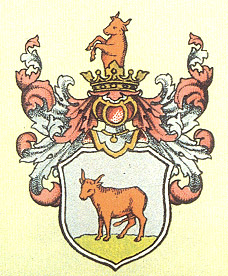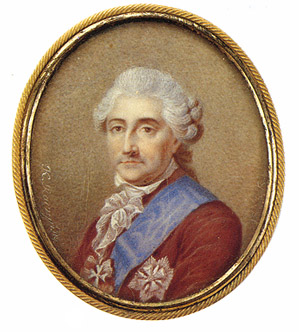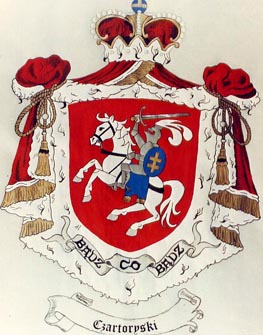

 ...
... 
The Poniatowski family was nobility before the year 1400, when they were associated with the Germans of Uradel. They received their name from the town/estate of Poniatowo, located near Pulawy, where they were installed in 1522. They were also listed as nobility in Bialystok, Kiew, Lwow, Minsk, and Vilno.
Stanislas August Poniatowski (1732-1798) was the son of Stanislas Poniatowski (1676-1762), a Lithuanian Stolnik, and (2)Princess Constance Czartoryska. His parent's wedding was on September 14, 1720.
He originally served as Poland's representative in the Russian court form 1735-1758, He was elected king after the death of King August II of the Saxon Dynasty, who was called Augustus III in Poland.
Children of Stanislas and Constance Poniatowski were:

In 1938, his remains were transferred to a church at Wolczyn, his birthplace, and in 1995, to St. John's Cathedral in Warsaw, where, on 3 May 1791, he had celebrated the adoption of the Constitution he had
co-authored and/or endorsed. Among his living relatives is Elena Poniatowska, a famous Mexican journalist. She was born May 19, 1932, in Paris, France.
Prince Michael Czartoryski (1697-1773) was chancellor of Lithuania, and Prince Augustus Czartoryski (d. 1782) was palatine of Polish Russia. They both failed in their efforts to reform the Polish constitution, and fell out of favor with King Augustus III (King of Poland). These two men were the uncles of Stanislaw August Poniatowski (on his mother's side). They secured the influence of Catherine the Great for their nephew. Prince Adam Jerzy Czartoryski (1770-1861) (grandson of Prince Michael) was a hostage after the insurrection in 1794.
Before he was king, Stanislas August Poniatowski benefitted from the support of Catherine II :the Great" of Russia. He was also one of her lovers, and many thought he was made a fool by her. The reign of Stanislaw August Poniatowski was called "The Age of Polish Enlightenment." When King Stanislaw came to power, he personally set up new schools throughout Poland. In 1765, he began the "School of Chivalry," which was Poland's first military school and non-religious college. This school was set up to train the elite of society and not only in manners of war. Its cadets included Tadeusz Kosciuszko, Jan Ursyn Niemcewicz, and Jakub Jasinski. In 1773, he oversaw the creation of the National Education Commission. A "Society of Elememtary Books" was established, and Poland began to produce some of the best textbooks in Europe.
A new appreciation of the intellectual side of life emerged and mass media thrived under his reign.
King Stanislaw also brought internationally famous artists to Poland.
Warsaw soon had many new churches, palaces, banks, and townhouses. These buildings were all executed in the late-Baroque and neo-classical styles. The Royal Castle was renovated too.
King Stanislaw helped create the Polish Constitution on May 3, 1791. Seeing that the Russians could not be conquered, at this time, he sided with the Constitutions opponents, the Targowica Confederates, and in 1795, after the third partition
King Stanislaw August Poniatowski was the last Polish king in Poland. of Polish blood. In the service of the king was Joseph Antoine Poniatowski (son of Andre Poniatowski and Therese nee Kinsky), from June 7, 1763. Joseph was in the battle of Leipzig. His nephew , General Josef Poniatowski distinguished himself at the battle of Zielence and the battle of Dubienka. Later he was marshal of France. The city of Paris, France, named a boulevard after Joseph. The Poniatowski family is of the Ciolek clan (see arms above). In 1764, the brothers of King Stanislas Augustus Poniatowski (Kazimierz, Andrej, and Michal) were awarded the hereditary title of Prince of Poland by the Polish Sejm. On December 10, 1765, Emperor Joseph II awarded Andrzej(Andrei) Poniatowski the hereditary title of the Prince of Pologne. Andrzej also received, on the same day) the hereditary title of prince of Austria, which would also be inherited by his first-born son. Casimir Marie Poniatowski inherited the Polish Ustrzycka bl. Przestrzal, and the son of Stanislas died on February 13, 1833 without heirs, making him the last of his princely line of Poniatowski.
SOURCES:
Konarski, Armorial de la Noblesse Polanais titre (Armorial of the Titled Polish Nobles)
This page was last updated on October 32, 2009
Events in his life:
Some notables of this time were:
These painters were:
Two natural sons of Stanislaus were:
.
There exists other branches of the Poniatowski family without titles. These families have the arms of Junosza, Nieczuja, and Szreniawa.
The Counts Ponaiatowski had among their ranks:
The Poniatowski was a patriotic man of the Polish state and served as Supreme Chief of the arms of the Duchy of Varsovie and marshal of France.
Tadeusz Kosciuszko was from the same time period as King Stanislaw Augustus Poniatowski. Kosciuszko became a colonel of engineers, Some military experts give him a sizable share of the credit for colonial vistories at Ticonderoga and Saratoga, and he was responsible for building fortifications at West Point. After he served as a Polish officer, he returned to America and worked against slavery. In 1764, Kosciuszko lead a second insurrection against the Russians, but he was captured in November 1794 and the plot collapsed. Kosciuszko was a veteran of the War of Independence (1775-1783) in America, and had hoped to gain the same independence for his homeland.
visitor since September 11, 2003
Email Margaret:
Margaret